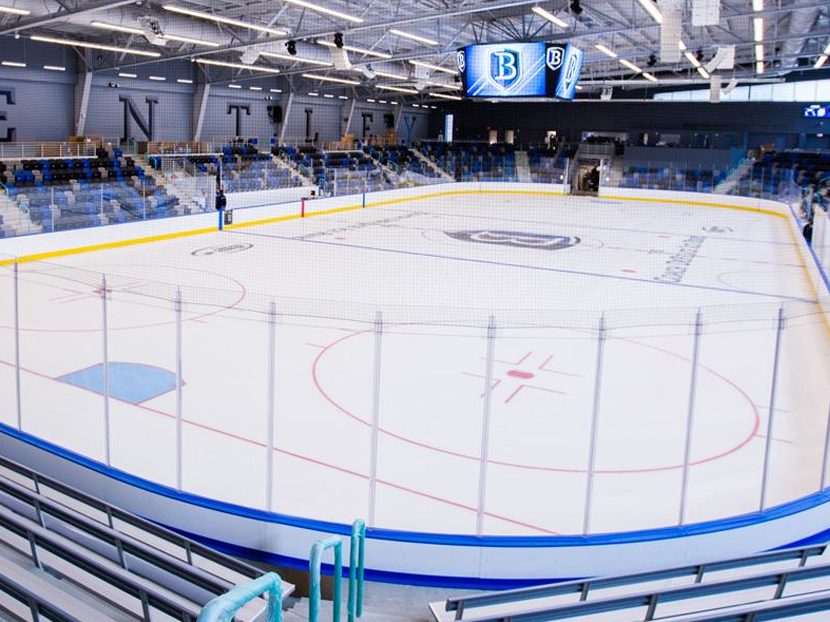Capturing Heat from Ice
Leading hockey arenas reduce emissions with heat reclamation.

What do the San Jose Sharks, Anaheim Ducks, St Louis Blues and Arizona Coyotes have in common? They’re National Hockey League teams and their arenas are getting greener. For St Louis it was their game rink; for the others, it was the practice sheets.
There could be others. Those are just the teams mentioned by Scott Ward of Stevens Engineering (Hudson, Wis.), a registered engineer in 26 states. He has worked on designs for heat reclamation systems for more than 225 arenas in the past couple of decades.
Ward says heat is captured and used to help with pre-heating of other systems in the building, reducing energy cost, increasing efficiency and reducing emissions. He also says more NHL projects are coming in the future. This is good news because it sets the example for everyone.
Heat Reclaim at Bentley Arena
One of the systems Ward thinks is a model that could become more broadly applied in the future was included recently in one of the greenest arenas in the country, the new Bentley Arena in Waltham, Mass., designed by the big brains at Architectural Resources Cambridge. It has won numerous clean energy awards and is the home arena for the Bentley Falcons, a National Collegiate Athletic Association Division I team.
The ice-making plant is a 160-ton, indirect flooded industrial-grade, custom-made system using R507 in the primary loop, with 50 tons of heat recovery or about 30 percent. The recovered heat is used for permafrost prevention below the ice rink subfloor, in the 40 F range, and to prewarm domestic hot water in the building to between 110 F and 130 F.
“Permafrost prevention is required for any arena that operates more than six or eight months; otherwise the soil begins to freeze up, which could threaten the building’s foundation,” Ward explains.
Reclaimed heat is used at around 85 F to melt the rink surface shavings in the ice pit. This means the Zamboni does not deposit ice and snow outside, eliminating the frequent opening and closing of large outside doors and messy cleanup. It saves more energy and water, and supports humidity control.
“We used reciprocating compressors that are rebuildable, open drive, not semi-hermetic,” Ward says. “The refrigerant does not come in contact and is not near heat from motors, so equipment is more efficient by about 10 percent to 15 percent, runs cleaner and has a longer lifespan.”
Sophisticated Controls
Ward describes the control system as a key feature because it is fully programmable. “You can preset the conditions for the compressors and pumps for practice mode when there are fewer bodies present, or game mode or off-season mode,” he explains. “It allows operators to optimize efficiency. Because they can see everything that’s happening and tweak things over time, they can squeeze as much efficiency as possible out of their energy.”
“We’re very proud of the Bentley Arena,” says Amanda King, executive director for the Office of Sustainability at Bentley University. “We have a 504 kW solar array on the roof, all-electric cooling, LED lighting and radiant heating in the lobby.” It’s a good thing they have modern controls.
Phil Whitton, a plumbing and fire protection engineer with Rist-Frost-Shumway Engineering in New Hampshire, notes: “We use hydronic heating around the perimeter but the rink space has forced air. It has to be kept at about 55 F to manage PH, avoid fog and bad ice. The players don’t like bad ice.”
The arena uses high-efficiency PVI Conquest 130-gal. condensing water heaters. “There were three tanks the ice-melt system was using, and we put coils in them,” Whitton adds. “We use heat reclaim from the ice plant to preheat domestic hot water.”
The showerheads and other fixtures are all low-flow, allowing the ice arena to hit its LEED targets.
“Arenas and ice plants are energy hogs, so we had to work hard to hit LEED Platinum,” says architect Jan Taylor, project manager at Architectural Resources Cambridge. “It’s a fabulous building with a lot of windows and natural daylight. And that was a challenge because you don’t want direct sunlight on the ice surface.”
“Right from the beginning, we were designing for sustainability and a multipurpose facility,” she adds. “In modern day, very few buildings can be designed for just one use. The Bentley Arena is used for hockey and figure skating, career fairs, camps, concerts and comedy shows. Despite all the competing needs, we were able to cut energy by about 60 percent. Clean energy has become a part of everything we do now. We can no longer ignore the effect of the built environment on the natural environment.”
King says: “Taking the extra time to explore all the mechanical options helped us push the envelope on the design. And it has been very rewarding. The arena is a living laboratory and we’re sharing solar data and energy meter data with students. They work with calculations on the energy offset and costs. We’re a business school and we offer two sustainability courses. The big takeaway here is that we’ve been able to demonstrate to students that the efficiency of buildings is inextricably linked to business performance.”
Upper Canada College
Heat reclaim is used in more and more arenas. Another educational institution, Upper Canada College in Toronto, offered an early example in 2014. An Eco Chill 150A package using R-717 refrigerant was connected to a thermal-equalized glycol system to employ waste heat for subfloor warming below two ice sheets, ice and snow melt, and service water heat for the Zamboni.
The system was combined with a ground-source geothermal field beneath a nearby soccer pitch. The combo also supplied domestic hot water and some radiant heat for dressing rooms, public washrooms, arena bench seating and visitors’ galleries.
Ammonia refrigerant has been re-emerging because it does not threaten the environment and costs much less than other alternatives. It was used in an arena in Nova Scotia with in-floor radiant, a Sabroe heat pump for heat reclaim from the ice plant, advanced controls and a modern cascading double-loop ammonia system. The ice-making and the heat pump energy recovery both employed ammonia and reciprocating compressors.
At first, the heat recovery didn’t quite work, so management brought in consultant John DeEll. “We did some modifications to the equalizing pipes so that when we transfer from simple condensing to heat recovery, we no longer see system upsets or ammonia hanging up in the condenser,” he says. “The heating loop was designed for 150 F but we found we could drop it to 120 F and cut heat pump condensing pressure from 500 to 300 psi.”
It saved energy and reduced wear and tear on the heat pump compressor. Operating costs went from $110,000 to less than $75,000. The arena also began running one compressor and one brine pump at a time, as well as shutting the system down at night, restarting in the morning and pumping built-up heat into the building. They installed variable-frequency drives, controlled amperage draw and reduced brine flow at colder temperatures. This decreased heat gains in the brine caused by friction.
In the fall of 2017, the college wanted to expand the facility, adding a curling pad, lounge, fitness center and meeting rooms, while maintaining the ammonia system and heat recovery. Once the slab temperature on the hockey surface reaches its set-point, the system along with the brine pump shuts down. They would have to find a way to control the curling slab temperature to within 0.4 of a degree and still recover heat.
They installed a variable-frequency drive for the curling brine pump and a reverse-return Tichelmann header, then tied the two pump sections together with a 1-in. diameter line. When the hockey brine was in operation, a small amount of brine would flow evenly through the curling slab. The control system was also adjusted.
Ammonia Can Kill You
Not all ammonia stories are happy stories. One man died in Boston in 2016 in a seafood warehouse and three techs died in a British Columbia arena in 2017. Obviously, it’s important to pay attention to the rules.
“If you walk into a room filled with it, it could easily kill you but you can smell it, so it will scare you away,” says DeEll. “It has to be a class T machinery room, with sensors and alarms, and an auto exhaust fan as required by the B-52 code.”
“All refrigerant is dangerous,” Ward notes. “Even 507 could suck the oxygen out of you. Ammonia gets more bad press because it’s more toxic but we’ve been using it fairly successfully since the 1800s. The safety systems are built into the code but the placement of devices and room layout matters, too. Design it correctly in the first place.
“The egress doors should be properly located, as well as safety devices and strobe alarms, pressure-release devices should vent into a water tank, two-stage ventilation fans, emergency stop buttons and manual switches outside the room. Techs need to be trained to use the systems that are in place.”
He predicts the re-emergence of ammonia is going to continue so companies planning to work with it should make sure the proper safety training is in place. His company has also installed some C02 and heat pump systems, and he the thinks they could become more popular as well. “C02 has its challenges because you can’t smell it,” he says.
NHL and other ice arenas are setting the example and becoming greener. Technicians also need to set the example. Whether you’re working on a new system or a familiar one, make sure your people are trained and that they are working more safely than ever before.





